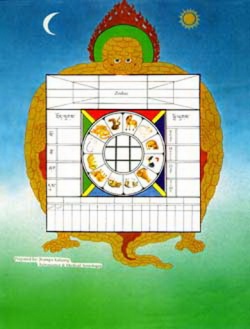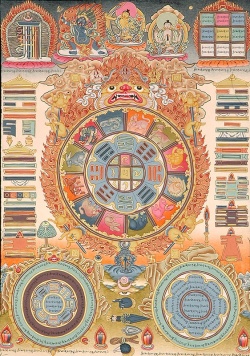Difference between revisions of "Astrology associated with Kālacakra"
m (Text replacement - "four hundred" to "four hundred") |
|||
| Line 47: | Line 47: | ||
===Style of [[astrology]]=== | ===Style of [[astrology]]=== | ||
| − | One [[word]] of warning. {{Wiki|Western}} [[astrologers]] are very used to a style of [[astrological]] textbook that is full of extensive explanations, worked examples, [[psychological]] interpretations, and so forth. The style in [[Tibetan]] and {{Wiki|ancient}} [[Indian]] texts, is very different. In fact, it is very similar to the style found in {{Wiki|western}} textbooks of [[astrology]] from, say, | + | One [[word]] of warning. {{Wiki|Western}} [[astrologers]] are very used to a style of [[astrological]] textbook that is full of extensive explanations, worked examples, [[psychological]] interpretations, and so forth. The style in [[Tibetan]] and {{Wiki|ancient}} [[Indian]] texts, is very different. In fact, it is very similar to the style found in {{Wiki|western}} textbooks of [[astrology]] from, say, four hundred years ago. |
That style is very literal, and could include such comments as: "Will [[live]] to be 60 days or 60 or 72 years, will be ill-tempered, fond of fine [[clothes]], with a father that will [[die]] young, and will [[die]] from the sword or snake-bite on a Tuesday." That is not a literal quote, but it sums up the style correctly. | That style is very literal, and could include such comments as: "Will [[live]] to be 60 days or 60 or 72 years, will be ill-tempered, fond of fine [[clothes]], with a father that will [[die]] young, and will [[die]] from the sword or snake-bite on a Tuesday." That is not a literal quote, but it sums up the style correctly. | ||
Revision as of 14:15, 30 December 2014
Introducton
Tibetan astrology uses as its basis a calendar very similar to that published on this website. The structure of that calendar is defined by calculations that are based on original methods given in the Kālacakra Tantra and its commentary the Vimalaprabhā. Two main Tibetan calendars survive today, from the so called Phugpa and Tsurphu systems. Many others were devised but survive only in textbooks.
The main differences between these systems were the calculations they used, and these diverged significantly due to differing interpretations of the calculations and methods of the Kālacakra Tantra. If one looks up the longitude of the Sun in a modern Tibetan calendar, bought in say, Dharmsala, Kathmandu or Lhasa, that longitude will be about 35° less than that found in a modern western ephemeris.
This is the key problem with the Tibetan calendar, and the Vimalprabhā, the Kālacakra commentary, makes it very clear that the longitude of the Sun needs to be correct, and needs to be adjusted according to the occurence of the winter solstice.
The developers of the Phugpa and Tsurphu calendars considered that the soltsice is observed in Tibet before it is observed in India – three weeks and two weeks earlier, respectively. This was built into their calculations and is the main cause of the errors in their calculations. (The 35° difference is a result of this calculation, plus other errors accumulated over 500 years – the calculations have not been adjusted in that time.)
We know of course that the solstice occurs at the same time for all places on the Earth, and at least one Tibetan calendar maker, Zhonnu Pal (gzhon nu dpal), also rejected the concept that the solstice was observed at different times. He therefore followed the instructions of the Kālacakra literature closely, and the longitude of the Sun he derived closely agreed with a modern tropical zodiac. Interestingly, his system is called the "Error Correction" system.
Closely associated with this difficulty over the longitude of the Sun is a discrepancy over the timing of the Indian months. Which problem came first is not clear, but the Sun is considered by the main Tibetan calendars to pass any point in the zodiac later than is actually the case. This means that the definitions of the months will be late, and many hundreds of years ago Indian experts, notably the famous Pandita Vimalaśrī, complained to the Tibetans that the Tibetan months were occuring one month later than they should.
This advice was most mostly ignored by the Tibetans, except by Zhonnu Pal, whose months agreed with those in India.
The basic structure of the calendar has symbolic information applied to it, from both Indian and Chinese systems, and the naming of the months – together with their other characteristics – is clearly a critical part of this. The calendar developed by Zhonnu Pal seems to have been the only one developed in Tibet for which descriptions survive that would have met with the approval of both Indian and Chinese calendar makers.
For what appear to be political reasons, the Phugpa calendar places the Chinese months a whole two months earlier than do Chinese calendars, putting the beginning of the Chinese new year – defined as the beginning of spring – back in December! This means that there is a three month error between the combinations of the Indian and Chinese months in the Phugpa system. The Tsurphu system usually agrees with the Chinese months, but due to occasional differences in the start of the year, they do not always match up.
So, the calendar published on this website takes the example of Zhonnu Pal, and follows the definitions of the Kālacakra literature closely, and defines the Chinese months in agreement with Chinese calendars.
Further symbolic information
Once the months and their attributes are settled, further symbolic information is added to the calendar, for the years and days. From the Chinese system this consists of the five elements and the twelve animals, the eight trigrams (known from the I Ching) and the nine numbers, all cycling through the years, months and double-hours (there are twelve of these in single day).
These notes are about the Indian system of astrology, and only the briefest information will be given about the various attributes from the Chinese system. Unfotunately, very little is written in the English language about Chinese astrology, and the only substantial work is: Tibetan Elemental Divination Paintings, by Gyurme Dorje, published by John Eskenazi, 2002.
There is no such thing as Kālacakra astrology as such, although Kālacakra does introduce some variations on accepted methods. It also has its own system of symbolism applied to the planets, lunar mansions, and so forth, but this is more associated with the maṇḍala of Kālacakra and its meditation methods than with astrology.
A Kālacakra astrologer is therefore expected to be familiar with general Indian astrology, and to use this together with the Kālacakra calendar. There is some material on this subject available in the English language, and some works worth recommending are these:
Bṛihat Saṃhitā, by Varāhamihira, translated by M. Ramakrishna Bhat. Two volumes. Motilal Banarsidass, Delhi, 1981.
Bṛihat Jatak, by Varāhamihira, translated by Prof P.S. Sastri, published by Ranjan Publications, Delhi, 1995.
Jatakachundrika, translated by B. Suryanarain Row.
Varāhamihira lived in the 6th century, and many classical works from that period deal with calculation (astronomy) rather than astrology. Any other Indian classical works that do deal with astrology would probably also be relevant for anybody wishing to learn the astrology associated with Kālacakra. There is also some information regarding the Hindu approach to Kālacakra and astrology available from Mike Magee, both here and [[Time and the Kalachakra - Indian astronomy|here]].
Also, many concepts that are familar in western astrology also apply in the Indian system. A Kālacakra astrologer would use the planets up to Saturn, locate them in the twelve signs of the zodiac, and also the twelve houses. The houses that are used are equal in size, and the whole sign that is rising at any time, the ascendant (dus sbyor, lagna), is considered to be the first house. The meanings applied to these are all essentially the same as in western systems, although concepts such as aspects, progressions and transits would not be used.
The main methods used with the Kālacakra system in addition to these are associated with the so-called five components of the calendar: the weekday, lunar day, lunar mansion, yoga and karaṇa. Amongst these, the lunar mansions are certainly the most important, and although these are known in western systems, they are little used.
The notes that are being developed for this website concern mainly the astrology of the five components, in particular the lunar mansions. These notes are being derived from many sources, mainly Tibetan, but many details can also be found in various odd places, such as the works of Varāhamihira, mentioned above.
Style of astrology
One word of warning. Western astrologers are very used to a style of astrological textbook that is full of extensive explanations, worked examples, psychological interpretations, and so forth. The style in Tibetan and ancient Indian texts, is very different. In fact, it is very similar to the style found in western textbooks of astrology from, say, four hundred years ago.
That style is very literal, and could include such comments as: "Will live to be 60 days or 60 or 72 years, will be ill-tempered, fond of fine clothes, with a father that will die young, and will die from the sword or snake-bite on a Tuesday." That is not a literal quote, but it sums up the style correctly.
Such literal descriptions are designed to bring a picture to mind, to be easy to remember, and to be a guide for an understanding of the attribute being described. They are not to be taken literally.
The approach of a Kālacakra astrologer would be very intuitive. Such an astrologer would be a regular practitioner of Kālacakra meditation. This would help develop the intuition, and the astrological charts and so forth would be used as guides for intuitive interpretation. The various literal explanations of the many attributes would have been memorized, and would form a framework for that intuitive interpretation.
Another similarity between Tibetan and classical Indian texts with old western works on astrology is the reduced emphasis on natal astrology, largely because of the lack of knowledge of people's time, and often also date, of birth. Much greater emphasis is placed on two other aspects of astrology: 1) horary astrology, using the time a question is put to the astrologer to determine the answer to the question or the solution to the problem posed by the question; and 2) electional astrology, using the time of an event (usually a proposed event, but also one that has already taken place) to determine the outcome of that event, such as choosing the best time and date for a marriage, establishment of a new building, etc.
E Henning.

